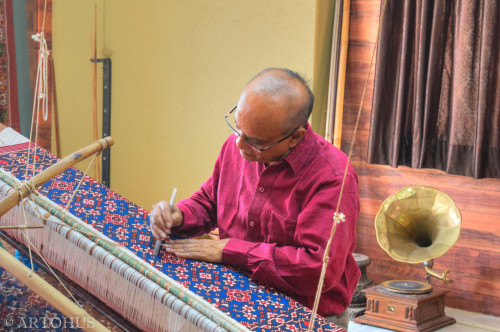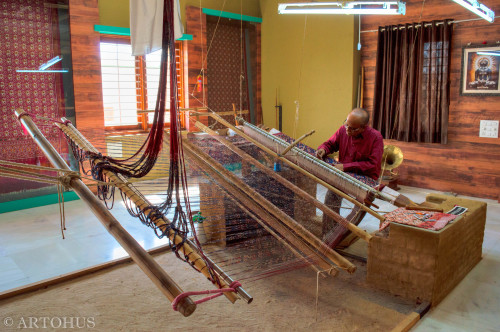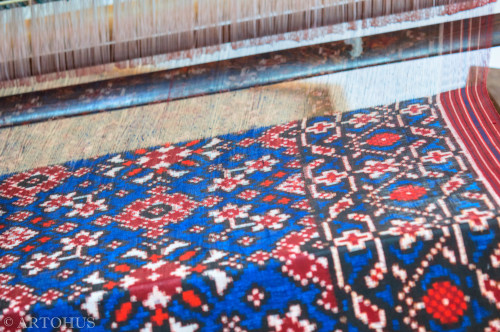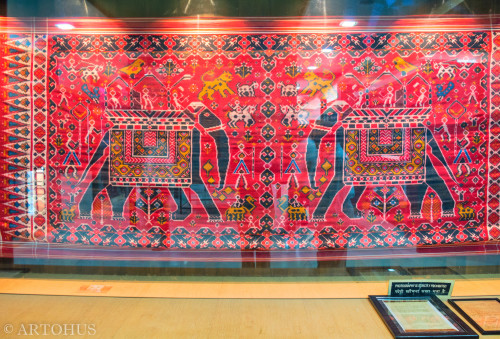by ARTOHUS
As the bus slowly snaked its way into the bus station, I peered out of the window. Before me lay a bustling, dusty little town teeming with people, shops and the usual mayhem of a small town bristling with newfound modernity. However, it was not for its modernity that I was here, rather for its timeless tradition.
Patan, a historical city situated in the state of Gujarat, India, is home to the world renowned Patola weavers. In fact, the two are often mentioned in the same breath.
As someone possessing avid curiosity for diverse cultures around the world, I often spend my leisure time reading about cultures and exploring them. I had heard about the famous Patola tradition of Gujarat from my mother and it immediately caught my interest. Patola is a form of silk sari woven using a very complicated process of “tie and dye” or “bandhani”. It is one of the most priceless Indian heritages that has been handed down over generations since the 11th century. The word Patola comes from the Sanskrit word “patta”. The first reference to Patola can be found in 1342 AD when it used to be given as gifts to kings in courts by the famous merchant traveller, Ibn Batuta. They continued to be used as precious gifts in the 17th and 18th centuries, being sent as far as Malaysia and Indonesia.
Around the 12th century, Anahilwad Patan or modern Patan was under the rule of King Kumarpal. The story goes that 700 Patola weavers, originally from Karnataka and Maharashtra, migrated to the court of King Kumarpal in Patan, Gujarat, for their trade to flourish, and to gain the patronage of the Chalukya Rajputas. There is also another side to the story, though. It is said that before the migration of Salvi weavers, King Kumarpal used to commission a new Patola robe every day for puja from King Jaina, the southern ruler of Maharashtra. However, furious that he was being sent used clothes, he attacked King Jaina’s kingdom and brought back 700 Patola weavers from Patan.
Today, the silk weavers of the Salvi family in Gujarat are the torchbearers of the Patola tradition. I once happened to read about them in detail in a National Geographic Magazine article. Once, I spent a year backpacking in Gujarat, exploring and documenting its various regions along with their cultures. It was then I decided that I shouldn’t miss the chance to witness the incredible Patola heritage. I booked an appointment at the Patola house, the residence of the Salvi family, and headed off.
I took an auto from my hotel near the bus station. It winded its way through the lanes of the ancient city with crumbling walls of the fort, the sole remnants of its erstwhile royal past. The driver dropped me in front of Patola House, an enormous sandstone edifice with ornate architecture and – home to the Salvi family.
The Salvi family comprises of Bharat and Rohit Salvi, two experienced weavers and the younger generation of weavers, Rohan and Savan Salvi. As I climbed up the steps of Patola House, it was Savan who greeted me.
“Patola weaving isn’t only about history. It is also intrinsically tied to the culture of Gujarat. There is a famous Gujarati folk song which goes like Chelaji re, mare hatu patan thi patola mongha lavjo (My dear! Please bring the precious patola from patan for me)”. This will make you understand how Patola has remained a strong culture symbol among Gujaratis,” Savan explained.
However, that is not all. Patola finds mention in the popular narrative of 17th century Gujarati poet Premanand, Kunvarbainu Nameru. Lakho Pachhedi Pandar kodi, Patola pachas vahuji (Let it be known that I will have 300 upper clothes and fifty patolas for marriages) reflects how Patola has been a symbol of high status. It has always been a tradition to gift Patola saris to daughters and daughters-in-law of wealthy families on their marriages as a harbinger of happiness. This venerable silk cloth is considered an attire for gods owing to its perfection. In countries like Indonesia, Malaysia and Thailand, people believe that Patola silk wards off evil with its mystic qualities.
Savan introduced me to Rohit Salvi, one of the veteran weavers of Salvi family who explained the entire process of Patola weaving to me.
One of the most complicated weaving processes in the world, Patola weaving requires expert craftsmanship and immense precision to produce a fine balance of silk threads to make the delicate cloth. First the design is marked out on the fabric on which the warp and weft silk threads are tied separately with cotton thread. Then the tied portions are dyed in one colour, untied, retied, dyed again in a different colour and so on. The next step is to put the threads of the warp in a sequence on the loom as per the design. The threads are then wound to bobbins and kept in a bamboo shuttle and the weaving process begins. The weaving process is done on a traditional handloom made out of rosewood and bamboo strips. The bamboo shuttle moves to and fro through warp shades. The weft threads are carefully matched with the warp design. To adjust the design, the tension of the warp threads are removed after weaving every 8 to 10 inches. This is the most important and complex part of the weaving process, requiring extreme dexterity. The perfection of the entire fabric depends on the accurate positioning of warp and weft threads of same colour.
According to Rohit, earlier, they used natural dyes. This was discontinued for several years and they began using chemical colours that dye easily and bleach quickly. But with time, they went back to sustainable alternatives like vegetable dyes. “There is a saying by a famous Gujarati poet about the colours we use: Padi patole bhat faatey pan phite nahin which means, the design created on the patola may be torn, but it will never fade,” Rohit Salvi shared.
The Patola saris are customised according to the clientele. For Hindus and Jains, flowers, birds, animals and dancing figures embellish the sari, while for Bohra Muslims, it is geometric and floral designs. The saris for Maharashtrian Brahmins have dark colours bordered with designs of women and birds (Nari Kunj). The other commissioned pieces are exported to markets in the Far East.
With the amount of precision and time required to complete a Patola sari, it is understandable that these are also one of the most expensive pieces of fabric. The technique is closely guarded and is only handed over to the sons. It also does not come as a surprise that the Patola weavers have been lauded with innumerable awards, including one by the then President of India, Dr APJ Abdul Kalam, in 2002.
With a precious heritage like this also comes a legacy. In view of this, the Salvi family have built a museum to document the rich heritage of Patola weaving.
“We had been planning the museum for 15 years and it was finally inaugurated in 2014. And yet all of this has been accomplished solely with our own means and finances without any aid from the government. Having carried on this heritage since the 11th century, it is our responsibility to make sure it still remains strong for days to come,” Rohit proclaimed proudly.
The museum is a brilliantly designed and informative centre to know more about this rare tradition. The brothers themselves become guides and show around curious visitors, explaining to them, their unique tradition with pride. The museum also houses the oldest Patola sari ever made, wrapped in muslin and kept in a drawer. Also worth seeing is a spectacular red Shikharbat sari which had taken three years to weave. Another is the gorgeous butter gold Dhaka mulmul.
The museum attracts a diaspora of people from across the globe including student groups, textile experts, media personnel, artists and celebrities. A glance through the guest feedback book can give an idea of how far this museum has gone in preserving and conserving an ancient heritage of India and spreading information about it around the world.
The most striking part of the museum is the huge handloom that stands at the right corner right near the entrance. In fact, that was where I stood talking to the brothers. Bharat Salvi, Rohit’s brother, sat there finishing a sari.
As I prepared to leave after penning a brief note in the feedback book, Rohit said, “The true strength of a civilisation lies in its heritage and that is the only thing worth preserving.” After having witnessed what I had, I couldn’t agree more.










